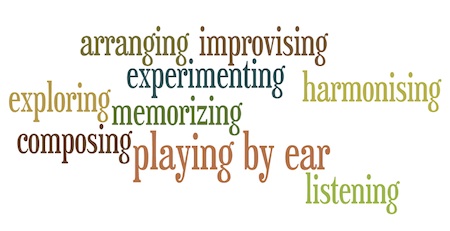One of the most effective ways to improve as a musician is to learn from multiple teachers, exploring different approaches and hearing from a variety of perspectives. So to continue our series on playing by ear, we decided to invite some teachers and musicians to share their own thoughts on learning to play by ear.
We’re starting today with Natalie Wickham from Music Matters Blog who shares her 4 steps to playing by ear. First though, a small confession…

My problem was the same as the one I encounter with most adult students who begin taking piano lessons from me. And it’s the same reason I’m not any good at playing by ear.
The official diagnosis? Unrealistic expectations for the amount of time and effort spent to achieve the desired end.
Playing by ear does not come naturally to me. I’m not good at it. And I don’t particularly enjoy working on it because I usually end up stuck in a rut playing the same thing over and over. For years I’ve tolerated this musical deficiency while wistfully imagining that someday, somehow, I’ll wake up in the morning and find that I’ve magically acquired the gift of playing by ear. Well, Christopher’s fabulous post on learning to play by ear put all such fantastic notions to rest for good :)
It’s time to get serious about learning to play by ear, and I’ve decided to drag my students along for the ride! Across the studio, no more of this wishful, generic longing to magically improve as pianists. If you’ve been living off of your imaginary dreams of pianistic prowess like me and are looking for a way to exchange cloud nine for reality, hold on to your piano benches because it’s time to kick it in high gear and move forward!
I invite you to join me in these 4 Steps to Achieve Your Goals:
1. Commit.
Not unlike crossing the street in Naples, Italy, the prospect of commitment is scary! One misstep on a frenzied, motorcycle-laden road and your life will flash before your eyes. But the reality is that if you don’t take that first step, you’re never going to get to the destination on the other side.

It’s a little less life-threatening to take on a new musical goal, but the risk of failure is every bit as real. Too often, that risk paralyzes us from making any progress at all. Start by determining and writing down a specific goal. Try asking this question that I’m posing to all of my students this year: “What do you want to be able to do by May that you can’t do now?”
2. Establish Accountability.
When something is intrinsically enjoyable, it’s not hard to spend time working on it. But when your aim is to improve an area that is difficult and not particularly fun, it calls for some sort of accountability. It’s helpful to know that what we’re doing matters and has relevance to our lives. Competitions, collaborative efforts, concerts, etc. all have a place in a musician’s life.
For my students and myself, I’ve decided to dub every fourth week, “Film Week,” where we’ll do a short recording of ourselves playing or sharing something we’ve learned in that time. These film clips will be posted on-line so we can track our progress throughout the year.
3. Enjoy the Process.
At a recent Creative Life conference I attended, one quote that was shared particularly stood out to me: “Productive artists aren’t afraid to produce insignificant works.”
I have to recognize that when I sit down to play a song by ear, I’m not going to sound like some awesome jazz pianist who can turn a simple tune into a virtuosic masterpiece. The truth of the matter is I’m not even going to sound as good as some of my students who already play naturally by ear!
I have to swallow my pride and admit that I’m a beginner and I’m going to sound like a beginner. There is nothing quite like being in beginner’s shoes to help us stay in touch with the emotions and processes of learning a new skill!
4. Use a Well-Rounded Approach.
Life as God designed it is very integrated. As much as we may try to compartmentalize various elements of our lives, they will always overlap, and every part of who we are will influence every other part.

As I contemplate what it will take to learn to play well by ear, I realize that my daily regimen needs to include a good dose of listening to the playing of great pianists, exploring new styles, experimenting with a variety of improvisation patterns (the Pattern Play series is my favorite for this!), picking out tunes by ear, trying new harmonies, composing original works, and memorizing some favorite piano pieces.
Learning to listen and develop more aural awareness in general as I go through the day will contribute greatly to developing my ear as a pianist as well.
I am excited to embark on this new journey of learning to play by ear. I’m a little freaked out, too! There’s no crystal ball to look into and assure myself that my plan will be successful.
But one thing is certain… If I don’t start taking steps in this direction, I do know for sure that I’ll never make it to the other side.
Thanks, Natalie, for this clear and practical advice on achieving musical goals!
Want to get started learning to play by ear? Here’s a suggestion for steps one (commit) and two (establish accountability):
Leave a comment below, sharing what you are committed to achieving in the next 6 months!








Definitely a post to share with my adult piano students